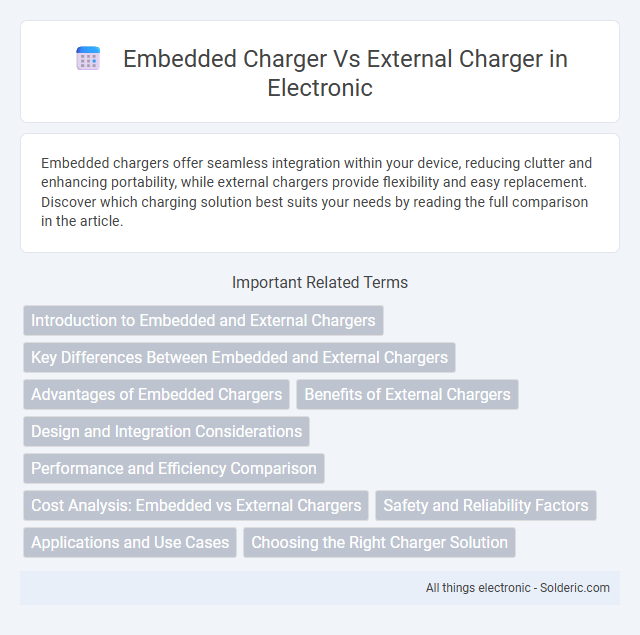Embedded chargers offer seamless integration within your device, reducing clutter and enhancing portability, while external chargers provide flexibility and easy replacement. Discover which charging solution best suits your needs by reading the full comparison in the article.
Comparison Table
| Feature | Embedded Charger | External Charger |
|---|---|---|
| Integration | Built into device; compact design | Separate unit; adds bulk |
| Portability | Always available; no extra accessories | Requires carrying additional charger |
| Charging Speed | Typically optimized for device; moderate speed | Often supports faster charging; higher wattage |
| Cost | Higher initial device cost | Lower device cost; additional charger cost |
| Repair & Replacement | Complex and costly to repair | Easy to replace or upgrade |
| Heat Management | Built-in cooling limitations | Better heat dissipation outside device |
| Compatibility | Specific to device model | Can be used across compatible devices |
Introduction to Embedded and External Chargers
Embedded chargers are integrated directly into electric vehicles, providing a seamless and space-saving charging solution, while external chargers are standalone units requiring a physical connection outside the vehicle. Embedded chargers usually offer lower power levels but enhanced convenience and portability, whereas external chargers can deliver higher power output and faster charging times. Understanding these differences helps you select the ideal setup based on your vehicle design and charging needs.
Key Differences Between Embedded and External Chargers
Embedded chargers integrate directly into your device, offering seamless charging without extra accessories, while external chargers function independently and connect via cables. Embedded chargers provide convenience and portability, eliminating the need to carry additional equipment, whereas external chargers are often more versatile and compatible with multiple devices. Power output and charging speed can vary, with embedded chargers typically optimized for specific devices and external chargers offering adjustable wattage options for broader use.
Advantages of Embedded Chargers
Embedded chargers offer seamless integration within electronic devices, reducing cable clutter and enhancing portability. They improve convenience by eliminating the need to carry extra components, ensuring your charging solution is always built-in and ready. Additionally, embedded chargers often provide optimized power management tailored to the device, increasing charging efficiency and safety.
Benefits of External Chargers
External chargers offer increased flexibility by allowing you to charge multiple devices without modifying the original equipment. They provide easier maintenance and replacements, reducing downtime and repair costs compared to embedded chargers. Enhanced portability and compatibility with various power sources make external chargers an efficient solution for diverse charging needs.
Design and Integration Considerations
Embedded chargers offer seamless integration within devices, reducing external components and enhancing overall design compactness and aesthetics. External chargers allow flexible placement and easier maintenance but may increase device size and cable clutter. Optimal design choice depends on device space constraints, thermal management needs, and user convenience preferences.
Performance and Efficiency Comparison
Embedded chargers typically offer higher performance and efficiency due to their direct integration with the device's power management system, minimizing energy loss and heat generation. External chargers may experience greater inefficiencies caused by longer power transmission paths and external environmental factors, reducing overall charging speed. Your choice between embedded and external chargers should consider these factors to optimize energy use and device longevity.
Cost Analysis: Embedded vs External Chargers
Embedded chargers typically incur higher initial costs due to integrated design and the need for specialized components, but offer long-term savings via reduced installation and maintenance expenses. External chargers present lower upfront costs and greater flexibility for upgrades or replacements, yet may lead to increased cumulative expenses from additional wiring, mounting, and potential compatibility issues. Evaluating total cost of ownership, including purchase price, installation labor, operational efficiency, and maintenance requirements, is crucial for determining the most cost-effective charging solution in specific applications.
Safety and Reliability Factors
Embedded chargers offer enhanced safety by integrating protective circuits directly within the device, reducing risks of electrical faults and overheating. External chargers, while convenient for portability, may have varied quality and lack consistent safety features, potentially leading to reliability issues. Embedded solutions provide more stable power management, minimizing voltage fluctuations and extending battery lifespan.
Applications and Use Cases
Embedded chargers are integrated directly into devices like electric vehicles and portable electronics, offering seamless charging without requiring additional components, ideal for automotive and consumer electronics applications. External chargers, commonly used in industrial equipment and medical devices, provide flexibility and ease of replacement, catering to scenarios where charging infrastructure varies or needs to accommodate multiple device types. Your choice depends on whether you prioritize compact integration or adaptable charging solutions tailored to specific use cases.
Choosing the Right Charger Solution
Choosing the right charger solution depends on your device's design, power requirements, and user convenience preferences. Embedded chargers offer seamless integration and reduced cable clutter ideal for portable electronics, while external chargers provide flexibility and easier replacement or upgrades. Evaluate your specific charging needs, space constraints, and maintenance considerations to determine whether an embedded or external charger best suits your setup.
Embedded charger vs external charger Infographic

 solderic.com
solderic.com